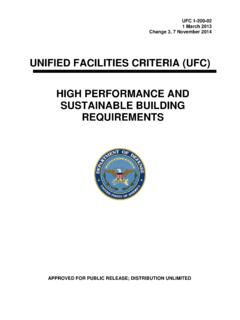Transcription of Table of Contents - acq.osd.mil
1 1. Table of Contents Table of Contents .. i 1. Background .. 1. SECTION 1 .. 3. Agile and EVM System Compliance .. 3. Organization and the WBS .. 3. Planning and Scheduling .. 5. Measuring Progress .. 7. Baseline Maintenance .. 8. Agile and Maintaining EVM System Compliance .. 10. Standard Terminology and Metrics .. 10. Agile Metrics and EVM Metrics .. 11. Traceability .. 11. SECTION 2 .. 11. Integrated Baseline Review Guidance .. 11. Introduction .. 11. IBR Execution .. 13. IBR Preparation .. 14. PMB Assessment .. 16. Management Processes .. 18. Summary .. 20. SECTION 3 .. 20. Agile Reports, Metrics and Analysis .. 20. Introduction .. 20. Delivered Functionality Metrics .. 20. Understanding Work in Process (WIP) .. 24. Agile Metrics Related to EVM Metrics .. 26. Comparison of Agile and EVM Status Charts .. 27. Resources for Additional Information on Agile Metrics.
2 29. APPENDIX .. 30. Example Agile and EVM Scenario .. 30. Agile Reference Terms .. 38. FIGURES. FIGURE 1. SW Development MIL-STD-881D Appendix K WBS breakout .. 4. FIGURE 2. Possible Agile SW Development MIL-STD-881D WBS breakout. Not prescriptive.. 4. FIGURE 3. Features support the completion and delivery of Capabilities. In the product backlog, Capabilities directly relate to the Control Account level of the WBS.. 5. FIGURE 4. A potential representation of an Agile product backlog 6. FIGURE 5. DoD Program Managers Guide to the Integrated Baseline Review Process .. 12. FIGURE 6. Typical Agile Development 13. FIGURE 7. Product Increment Reviews follow a typical time-boxed planning process.. 14. FIGURE 8. Example Product Roadmap derived from NDIA An Industry Practice Guide for Agile on Earned Value Management Programs, Version , dated March 31, 17.
3 FIGURE 9. Example Data Trace showing work decomposition and use of weighted stories to collect and provide Agile progress, at the Feature level, to the IMS.. 18. i APPROVED FOR PUBLIC RELEASE DISTRIBUTION UNLIMITED: 18-S-1362, April 20, 2018. FIGURE 10. Velocity Diagram for Two Different Teams .. 21. FIGURE 11. Increment Burn-Down Chart .. 22. FIGURE 12. Release Burn-Up .. 23. FIGURE 13. Capability Progress Charts (Derived from SAFe Metrics) .. 24. FIGURE 14. Cumulative Flow Diagram 25. FIGURE 15. Example Data Trace showing work decomposition and use of weighted stories to collect and provide Agile progress, at the Feature level, to the IMS.. 28. FIGURE 16. Cumulative Data and EAC 28. FIGURE 17. EAC Projections EVM Gold Card Metrics with Agile-Informed 29. APPENDIX FIGURES. APP FIGURE 1. Shows alignment of EVM WBS elements to the Agile products hierarchy.
4 31. APP FIGURE 2. Shows Feature Time-phasing using story points.. 32. APP FIGURE 3. Shows how the Agile information can manifest itself as progress information in the IMS and BCWP for the control account.. 33. APP FIGURE 4. Simple Scenario 34. APP FIGURE 5. Simple Scenario Time Phased Budget .. 34. APP FIGURE 6. Agile Status by Sprint for this scenario .. 35. APP FIGURE 7. Calculation of BCWP by Sprint .. 36. APP FIGURE 8. Status IMS after Sprint 4 .. 36. APP FIGURE 9. EVM Metrics by Sprint .. 37. APP FIGURE 10. EVM Metrics by Month .. 37. ii APPROVED FOR PUBLIC RELEASE DISTRIBUTION UNLIMITED: 18-S-1362, April 20, 2018. This document is intended as an informative resource for Department of Defense (DoD) personnel who encounter programs on which Agile philosophies and Earned Value Management (EVM) are applied. It is not an official policy, nor is it a step-by-step handbook for Agile implementation or the application of EVM.
5 Foreword The DoD acquisition process supports the procurement and production of large, strategic, and deployable systems to address specific threats. Per the DoD Defense Acquisition System Directive , an acquisition system is a directed, funded effort that provides a new, improved, or continuing materiel, weapon or information system, or service capability in response to an approved need [t]he primary objective is to acquire quality products that satisfy user needs with measurable improvements to mission capability and operational support, in a timely manner, and at a fair and reasonable price. Constantly evolving threats have presented a demand for an acquisition process that is able to respond quickly to emerging requirements and rapidly changing environments. To address this, the DoD has encouraged the following characteristics in acquisitions: 1.
6 Flexibility: tailoring program strategies and oversight 2. Responsiveness: rapid integration of advanced technologies 3. Innovation: adapt practices that reduce cost and cycle time 4. Discipline: use of program baseline parameters as control objectives 1. 5. Effective Management: decentralization to the extent practicable These characteristics have led to an increased focus on flexible development approaches that include Agile philosophies and integrated program management tools such as Earned Value Management. With practice, integrating EVM and Agile has led to more success preparing for and managing the Integrated Baseline Review (IBR). By better understanding how the Agile methodology and the Earned Value Management program tool interact, programs are better able to measure status through Agile metrics and track success over time.
7 Background Agile philosophies promote rapid incremental product deliveries, provide flexibility to respond to changing requirements, and advocate close customer collaboration. A major aspect of Agile is that changes to requirements, design details, or functional capabilities can be incorporated based on customer value, at any stage of the development cycle. While Agile is primarily used on software development projects, Agile methods are being used for complex system and hardware developments as well. Agile for software development in the DoD is still an emerging product development approach. To be effective, the adoption of Agile methodologies must be integrated with existing DoD program management (PM) and system engineering (SE) processes. EVM is a disciplined integrated program management tool used to provide joint situational program awareness.
8 EVM is used to measure technical progress against a baselined plan, independent of the consumption of resources. EVM is not tied to any specific development methodology and provides decision-makers with objective cost at completion forecasting as well as dollarized values of accomplishments and variances to the baseline plan. The requirement for EVM demands that performing contractors maintain an EVM System (EVMS) consistent with the 32 guidelines contained in the Electronic Industries Alliance Standard-748 (EIA-748) document. For DoD programs, EVMS implementations are evaluated in accordance with the DoD Earned Value Management System Interpretation Guide (EVMSIG) 2 . As a result, a contractor's EVMS provides the 1. DoDI , The Defense Acquisition System, May 2003. 2. Department of Defense Earned Value Management System Interpretation Guide, 2015.
9 1. APPROVED FOR PUBLIC RELEASE DISTRIBUTION UNLIMITED: 18-S-1362, April 20, 2018. structure to establish and maintain a credible Performance Measurement Baseline (PMB), which is the plan to accomplish a given contractual scope of work. Agile and EVM are complementary when properly implemented together, and help enable a robust overall management process. In order to be effective, Agile must be evaluated for its applicability on a program- specific basis and tailored to best align with programmatic and contractual requirements. Introduction The origins of Agile Development can be traced back to 1957 to the incremental development of a large simulation by IBM's Service Bureau Corporation for Motorola. 3 By the mid-1980s the DoD formally recognized the value of adaptive software development in the DoD's Military Standard for Software Development (DOD-STD-1679A).
10 Throughout the 1990s, several other lightweight iterative development methods emerged including Dynamic Systems Development Method (DSDM), Scrum, and eXtreme Programming (XP). These methods, along with others, became collectively known as Agile methodologies. The tenets of Agile were codified with the creation of the Agile Manifesto in 2001. The Manifesto emphasizes the following major concepts: Individuals and interactions over Processes and tools Working software over Comprehensive documentation Customer collaboration over Contract negotiation Responding to change over Following a plan while there is value in the items on the right, we value the items on the left more. 4 For example, though the ability to respond to change is valued over following a plan, having and adhering to a plan remains essential for project completion.










